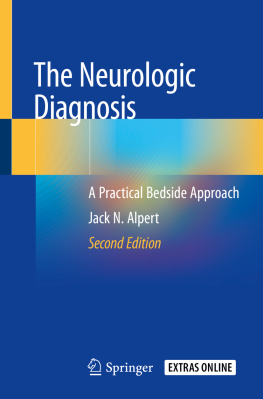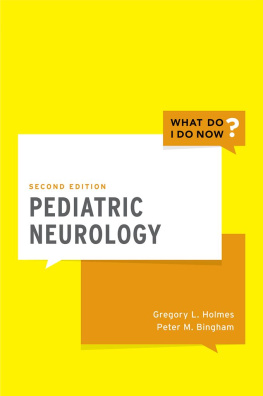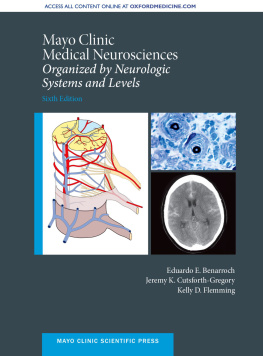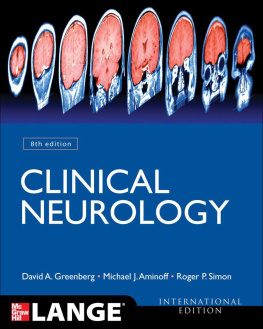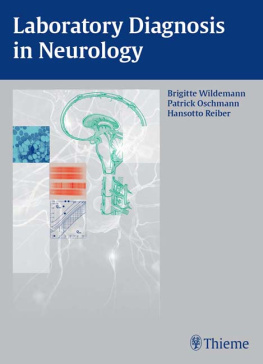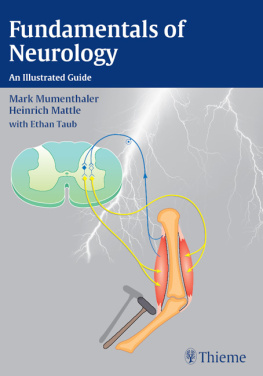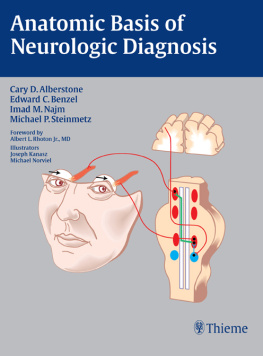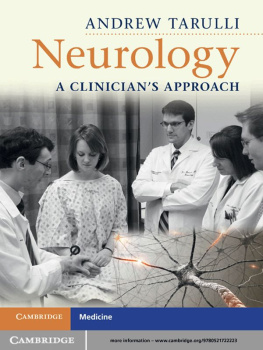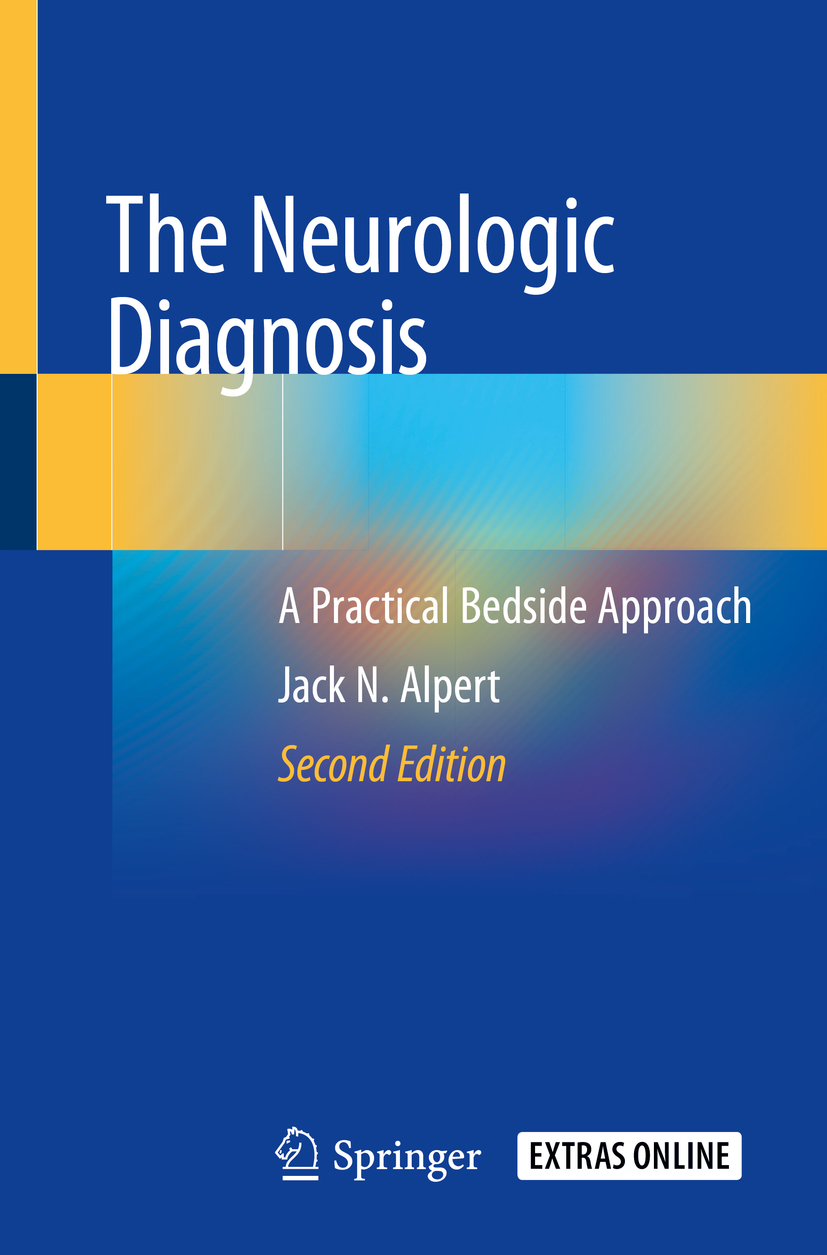Jack N. Alpert
The Neurologic Diagnosis A Practical Bedside Approach 2nd ed. 2019
Jack N. Alpert
Department of Neurology, University of Texas Medical, School at Houston, Houston, TX, USA
ISBN 978-3-319-95950-4 e-ISBN 978-3-319-95951-1
https://doi.org/10.1007/978-3-319-95951-1
Library of Congress Control Number: 2018956294
Springer Nature Switzerland AG 2019
This work is subject to copyright. All rights are reserved by the Publisher, whether the whole or part of the material is concerned, specifically the rights of translation, reprinting, reuse of illustrations, recitation, broadcasting, reproduction on microfilms or in any other physical way, and transmission or information storage and retrieval, electronic adaptation, computer software, or by similar or dissimilar methodology now known or hereafter developed.
The use of general descriptive names, registered names, trademarks, service marks, etc. in this publication does not imply, even in the absence of a specific statement, that such names are exempt from the relevant protective laws and regulations and therefore free for general use.
The publisher, the authors, and the editors are safe to assume that the advice and information in this book are believed to be true and accurate at the date of publication. Neither the publisher nor the authors or the editors give a warranty, express or implied, with respect to the material contained herein or for any errors or omissions that may have been made. The publisher remains neutral with regard to jurisdictional claims in published maps and institutional affiliations.
This Springer imprint is published by the registered company Springer Nature Switzerland AG
The registered company address is: Gewerbestrasse 11, 6330 Cham, Switzerland
In memory of Morris B. Bender, a superlative clinical neurologist of the twentieth century, who stimulated my lifelong interest in the manifestations, evaluation, and diagnosis of patients with neurologic diseases. His influence permeates this text.
Foreword
Assessment of neurological complaints, a high percent of a family practitioner and internists practice, requires an accurate history and a careful neurologic examination. As Dr. Alpert expertly discusses in detail, the history provides clues to the clinical diagnosis, while the complementary neurologic examination localizes the lesion(s). Dr. Alpert is able to distil out from his over four decades of a busy practice and from his excellent teaching of medical students and neurological trainees a logical, readable, and provocative approach to each neurological complaint. In a chapter of 42 cases of Diagnostic Dilemmas , ones clinical acumen is challenged with practical questions and astute observations.
By discussing neurological disorders in terms of ten Neuroanatomic Diagnoses , Dr. Alpert compartmentalizes neurologic diseases into convenient and manageable discrete entities. By building upon the unique anatomy and physiology of each unit, greater logic is made in ones deductive reasoning for a diagnostic conclusion. Special emphasis is given to the Six Major Decussations with clinical correlations, as with strokes, autonomic disorders, neuromuscular diseases, and the poorly responsive patient. A separate chapter on Common Symptoms in the Neurology Clinic is a potpourri of frequently seen and rare cases which will challenge the beginner and the experienced practitioner of neurology. This textbook is highly recommended to the serious student of clinical neurosciences, be they medical students, trainees, or practitioners.
Frank M. Yatsu
Preface
The second edition of this book retains the same emphasis on the simplification of making a neurologic diagnosis. The unique diagnostic principles of neurology are based on the requirement of an anatomic definition of the disease before a differential diagnosis can be offered. This process often disrupts the thinking of medical students and residents and certainly adds to the confusion of the practicing physician, thus providing the necessity for neurologic expertise and consultations. The explosion of efficacious treatment options for common neurologic diseases and disorders such as headache, epilepsy, multiple sclerosis, Parkinsons disease, sleep disorders, and stroke mandates an accurate diagnosis which depends on a thorough history and meticulous neurologic examination. This initial, critical, first step is the focus of this text.
The first eight chapters provide core knowledge of neuroanatomy and diagnostic principles. They include several updates on clinical-neuroanatomic correlations so that a rereading, although repetitive to some extent, should remain useful. Chapter on myelopathies not provided in the first edition adds brief discussions of a group of diseases which uniquely target the spinal cord. Although some are uncommon or rare, it is important to be mindful of them. As multiple sclerosis often begins with myelopathic features, the discussion of one case furnishes an opportunity for elaboration of new diagnostic criteria according to the recent (2017) revisions of McDonalds criteria. These are briefly summarized. A full review will require a return to source material.
Chapter remains focused on the practical diagnosis of common neurologic diseases and disorders. The International Classification of Headache Disorders (ICHD), third edition reported in Cephalalgia (2013) supplies the substrate for a reexamination of these entities. Positron emission tomography (PET) imaging of the brain during migraine, relatively unknown among most medical practitioners and some neurologists, is now included. The section on vertigo has been enlarged by the addition of new cases as well as modified by the clarification and explication of relatively new clinical signs. The section on epilepsy incorporates the International League Against Epilepsy (ILAE) classification of epilepsies published in Epilepsy (2017). The transition from the old terminology will undoubtedly be resisted but, nevertheless, eventually accepted, likely over many years since the prior classification in 1981 held force for decades. Discussion of psychogenic factors has been expanded and incorporates principles of differentiating psychogenic non-epileptic seizures (PNES) or pseudoseizures from seizures and psychogenic pseudosyncope (PPS) from syncope. The section on sleep disorders has broadened and will include elements of the most recent International Classification of Sleep Disorders 3rd Edition 2014. Understanding these conditions is increasingly recognized as furnishing important clinical clues for diagnoses, such as recognizing rapid eye movement (REM) sleep behavior disorder as a prelude to Parkinsons disease, as well as providing treatment opportunities for the maintenance of overall health.
In Chap. , additional syndromes have been added, always intriguing for many neurologists, since they add an element of historical interest.
The relevance of the neurologic examination has been questioned by many physicians, including some experienced neurologists. There have even been statements that simply reviewing an MRI scan with a neuroradiologist could easily be more valuable. Forgotten, astonishingly, is the reality that the majority of patients visiting most neurologic clinics have normal studies. Just think of migraine, epilepsy, Parkinsons disease, sleep and neuromuscular disorders, as well as neuro-otologic conditions whose diagnoses depend on a thorough history and neurologic examination. Additionally, the benefit of a soothing touch which may convey interest and empathy by the caring, thoughtful examiner provides a form of treatment by reducing the discomfort of anxiety. Abandonment of this gift which is bequeathed to all physicians is a developing tragedy of modern medicine.

